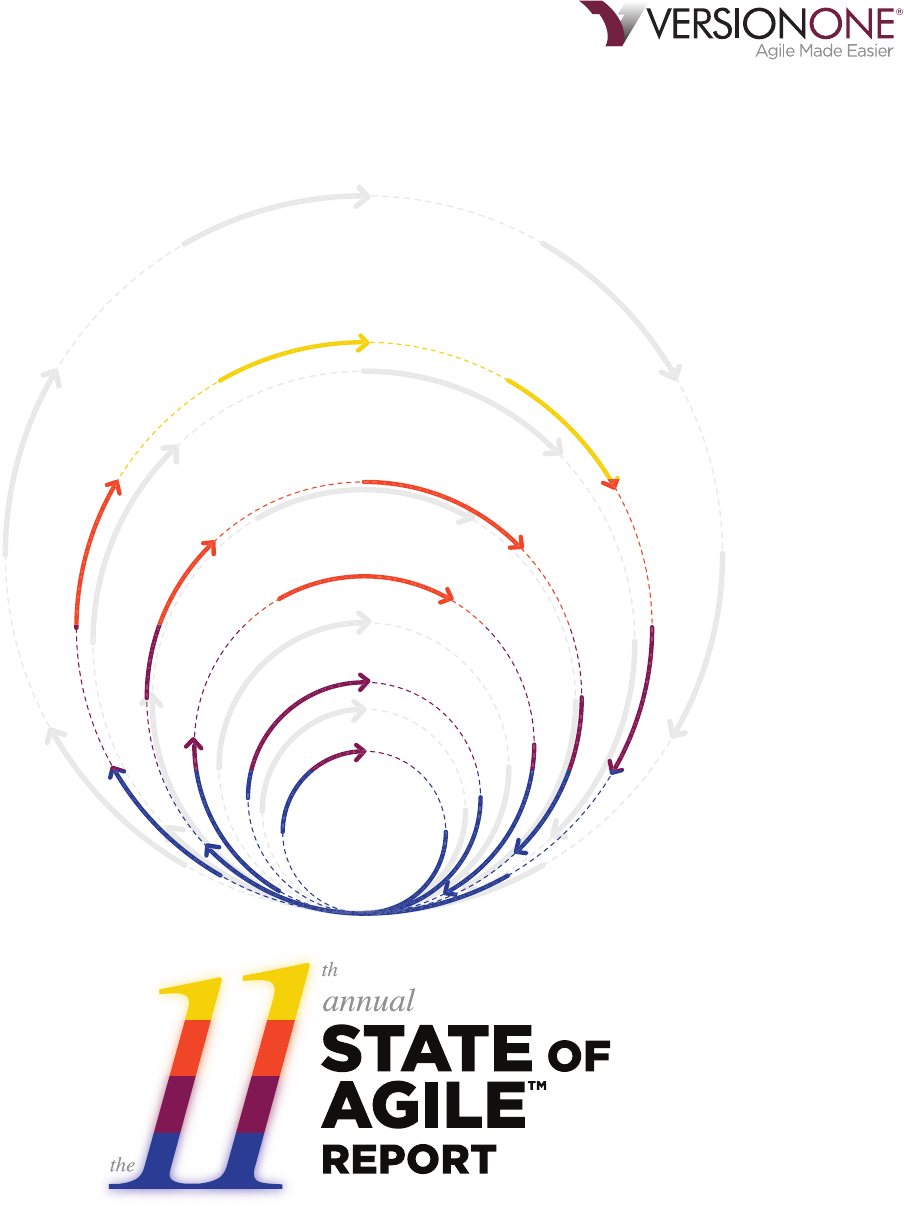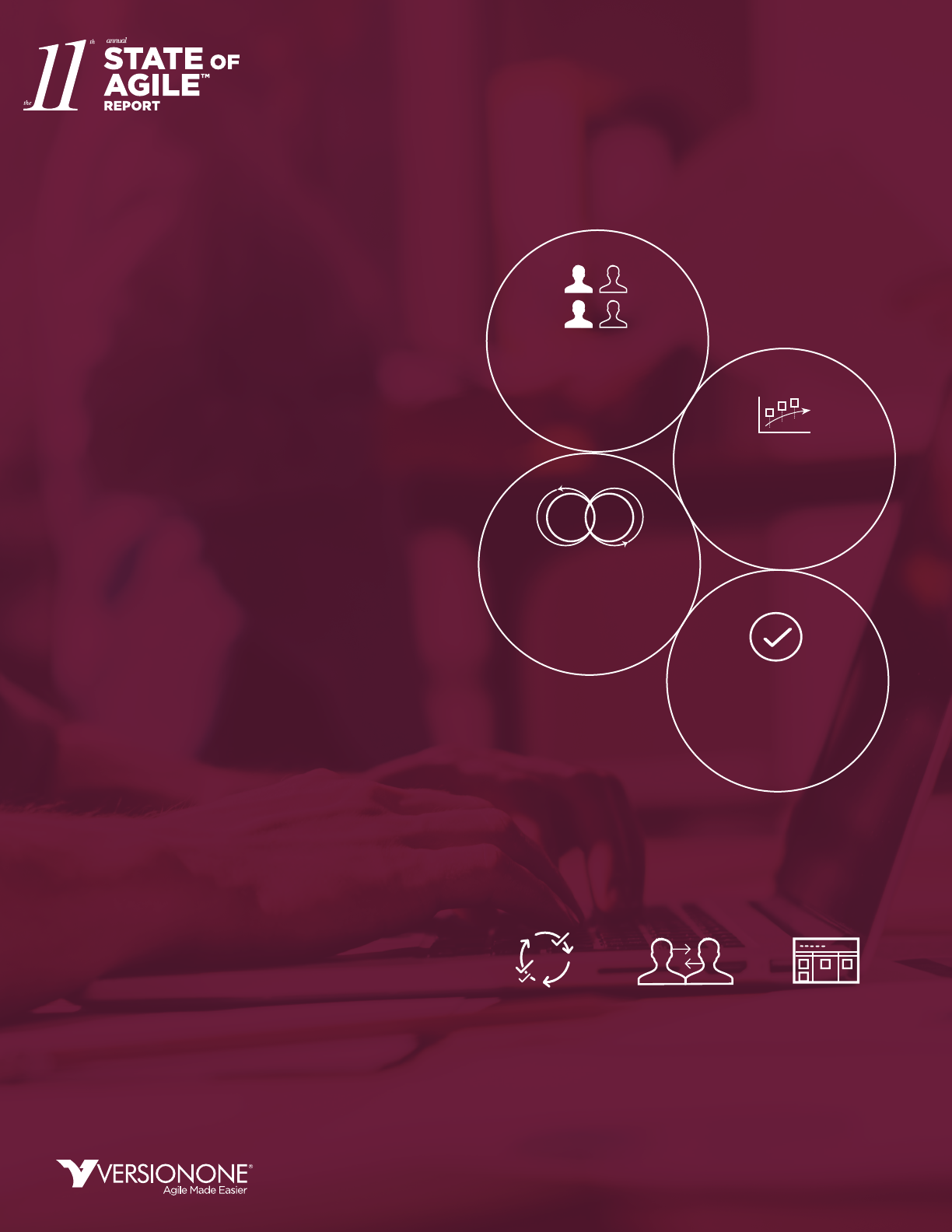
VERSIONONE.COM
2
#StateOfAgile
EXECUTIVE SUMMARY
AGILITY ACCELERATES THE DELIVERY OF BUSINESS VALUE
VERSIONONE.COM
The 11th annual State of Agile™ survey found
that enterprise agility is increasing throughout
organizations and across almost all industries at an
accelerated rate. For the first time, half of the survey
respondents came from outside North America.
While the largest number (23%) of respondents
still worked for software companies, the number
from non-software companies grew significantly in
2016. Respondents from very large organizations,
employing more than 20,000 people, also
increased.
However, the survey also highlights that there
is still a lot of opportunity for growth and that
the momentum is far from slowing. While 94% of
respondents said their organizations practiced agile,
they also stated that more than half (60%) of their
organizations’ teams are not yet practicing agile.
Similarly, although 44% of respondents stated that
they were extremely knowledgeable regarding agile
development practices, 80% said their organization
was at or below a “still maturing” level. Finally,
the survey showed that many companies are now
investing (71%) in DevOps.
Just as the survey made it clear that there are still
opportunities for increasing enterprise agility, it
also made clear that there are many reasons for
improving agility. 98% of respondents said that
their organization has realized success from agile
projects. Respondents stated that the top benefits
from adopting agile were accelerated delivery,
better project visibility, improved team productivity,
and management of changing priorities.
Top 3 Benets of Agile
Ability to manage
changing priorities
Increased team
productivity
Improved project
visibility
Respondents continue to cite the same top three benefits of
adopting agile for the sixth year in a row.
2
#StateOfAgile
realized success
from agile
projects
98%
investing in
DevOps
71%
have less than
½ of teams
practicing agile
60%
at or below “still
maturing” level
with agile
80%

VERSIONONE.COM
3
#StateOfAgile
EXECUTIVE SUMMARY
AGILITY ACCELERATES THE DELIVERY OF BUSINESS VALUE
MEASURE ENTERPRISE AGILITY
WITH BUSINESS VALUE
One of the most notable trends from the survey is the
importance of measuring how much business value
your organization is delivering. This year business value
has become a much more popular measure of an agile
initiative’s success.
Business value was cited as the second most popular
measure (46%) of an agile initiative’s success, rising
from fourth in the prior year. Conversely, it ranked as the
eleventh most popular measure (23%) on a day-to-day
basis. This highlights an important inconsistency between
how more strategic areas of the enterprise are measuring
success and how success is being measured at the team
level.
LOOKING FORWARD
As more organizations’ enterprise agile initiatives mature,
the need for consistent processes and tools for managing
and measuring the flow of business value across the
entire value stream will become critical (or similar). To
achieve this, enterprises will need to truly unify their
agile portfolio planning, agile project management, and
continuous delivery eorts.
This will further decrease the use of spreadsheets and
team-oriented point solutions as organizations seek a
more enterprise-centric solution for unifying their Agile
and DevOps initiatives and accelerating the delivery of
business value across the entire organization.
ENTERPRISE AGILITY SUCCESS
With so much momentum and opportunity around agility,
it is important to understand what the best organizations
are doing to succeed. Executive sponsorship (48%),
consistent process and practices (41%), implementation
of a common tool across teams (36%), and agile
consultants or trainers (36%) continue to be cited in the
top five tips for successfully scaling agile.
RECOMMENDED AGILE PROJECT
MANAGEMENT TOOLS
This was the first year that more respondents cited using
agile project management tools than spreadsheets.
This is no doubt due to companies succeeding through
implementing consistent processes, practices, and tools
across teams. For the fifth year in a row, VersionOne
had the highest recommendation rate of any other
tool evaluated in the survey, even though only 20% or
respondents used VersionOne.
VERSIONONE.COM
3
#StateOfAgile

VERSIONONE.COM
4
#StateOfAgile
ABOUT
THE SURVEY
The 11
th
annual State of Agile survey was
conducted between July and December,
2016.
Sponsored by VersionOne, the survey
invited individuals from a broad range
of industries in the global software
development community and was
promoted far beyond VersionOne’s
customer base at tradeshows and
multiple digital channels. Thousands
of responses were collected, analyzed,
and prepared into a summary report by
Analysis.Net Research, an independent
survey consultancy. Only 20% of the
respondents were VersionOne customers,
indicating the range and diversity of
respondents.
1
RESPONDENT
DEMOGRAPHICS
SECTION
Size of Organization
Size of Software Organization
Location of Organization
Role
Industries
Distributed Agile Teams
5
5
5
6
6
6
2
COMPANY
EXPERIENCE
AND ADOPTION
SECTION
Personal Experience with
Agile Development Practices
Company Experience
Percentage of Teams Using Agile
DevOps Initiative
Reasons for Adopting Agile
Agile Maturity
7
7
7
7
8
8
3
BENEFITS
OF AGILE
SECTION
Benefits of Adopting Agile 9
4
AGILE
METHODS
AND
PRACTICES
SECTION
Agile Methodology Used
Top 5 Agile Techniques
Agile Techniques Employed
Epic Estimation Unit of Measure
Engineering Practices Employed
Agile in Outsourced Development
Projects
10
10
10
11
11
11
5
AGILE
SUCCESS
AND
METRICS
SECTION
Success of Agile Projects
Challenges Experienced Adopting &
Scaling Agile
How Success Is Measured
With Agile Initiatives
How Success Is Measured
With Agile Projects
12
12
13
13
6
SCALING
AGILE
Scaling Methods and Approaches
Top 5 Tips for Success with Scaling Agile
14
14
SECTION
7
AGILE PROJECT
MANAGEMENT
TOOLS
SECTION
General Tool Use and
Preferences
Use of Agile Management Tools
Recommended Agile Project
Management Tools
15
16
17
TABLE OF CONTENTS
VERSIONONE.COM
4
#StateOfAgile
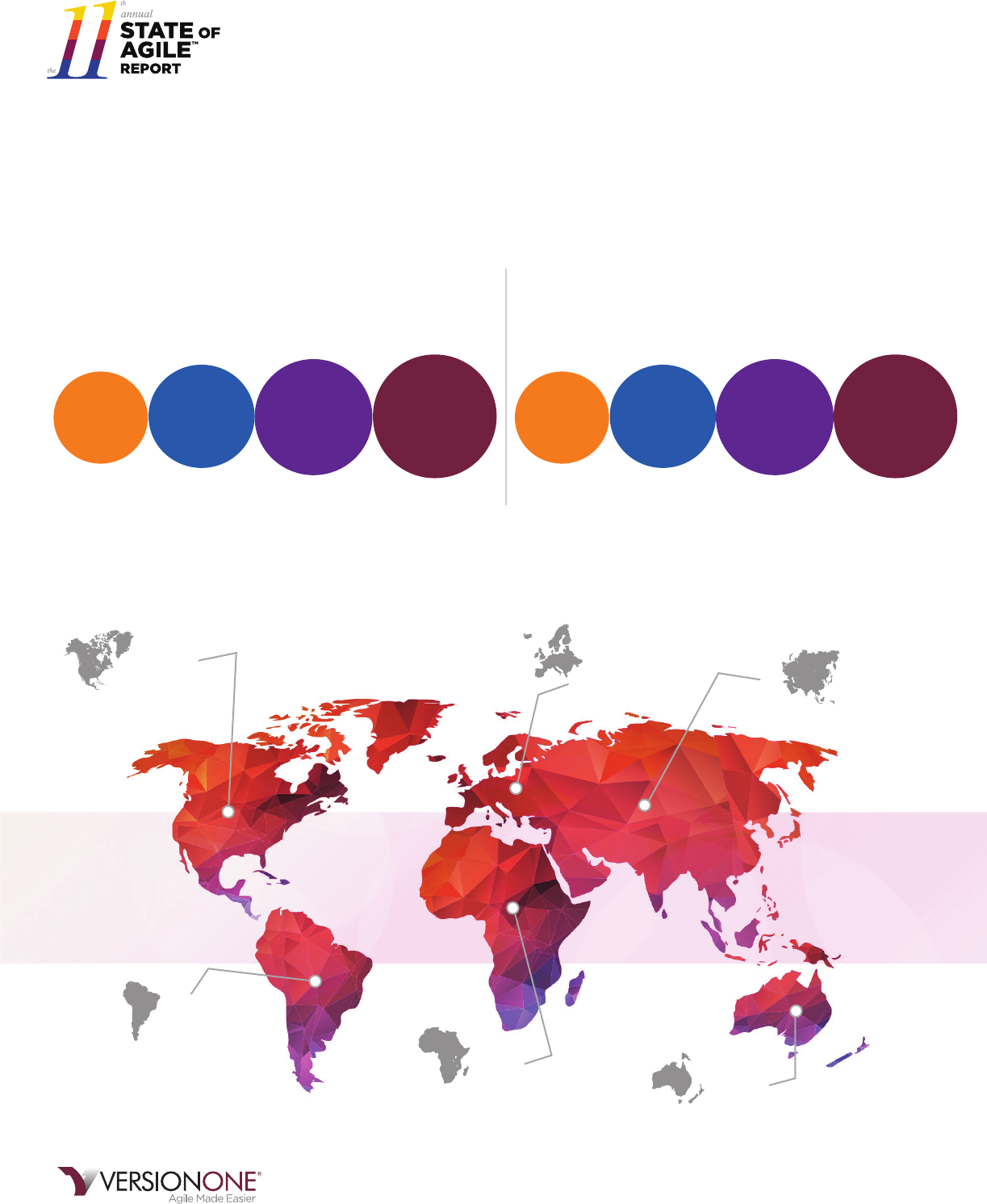
VERSIONONE.COM
5
#StateOfAgile
RESPONDENT
DEMOGRAPHICS
For the first time, half of the respondents were from outside North America.
While the largest number of respondents (23%) worked for software/ISV
companies, that number declined from 26% last year. Respondents from very
large organizations, employing more than 20,000 people, increased from 24%
last year to 26% this year.
Size of Organization
Respondents who worked for organizations with:
Size of Software Organization
Respondents who worked for organizations
with software groups with:
Location of Organization
Respondents were from:
50%
North America
28%
Europe
2%
Africa
5%
South America
10%
Asia
4%
Oceania
< 1,000
people
39%
1,001-5,000
people
18%
5,001-20,000
people
17%
20,001+
people
26%
< 100
people
32%
101-1,000
people
34%
1,001-5,000
people
15%
5,001+
people
19%
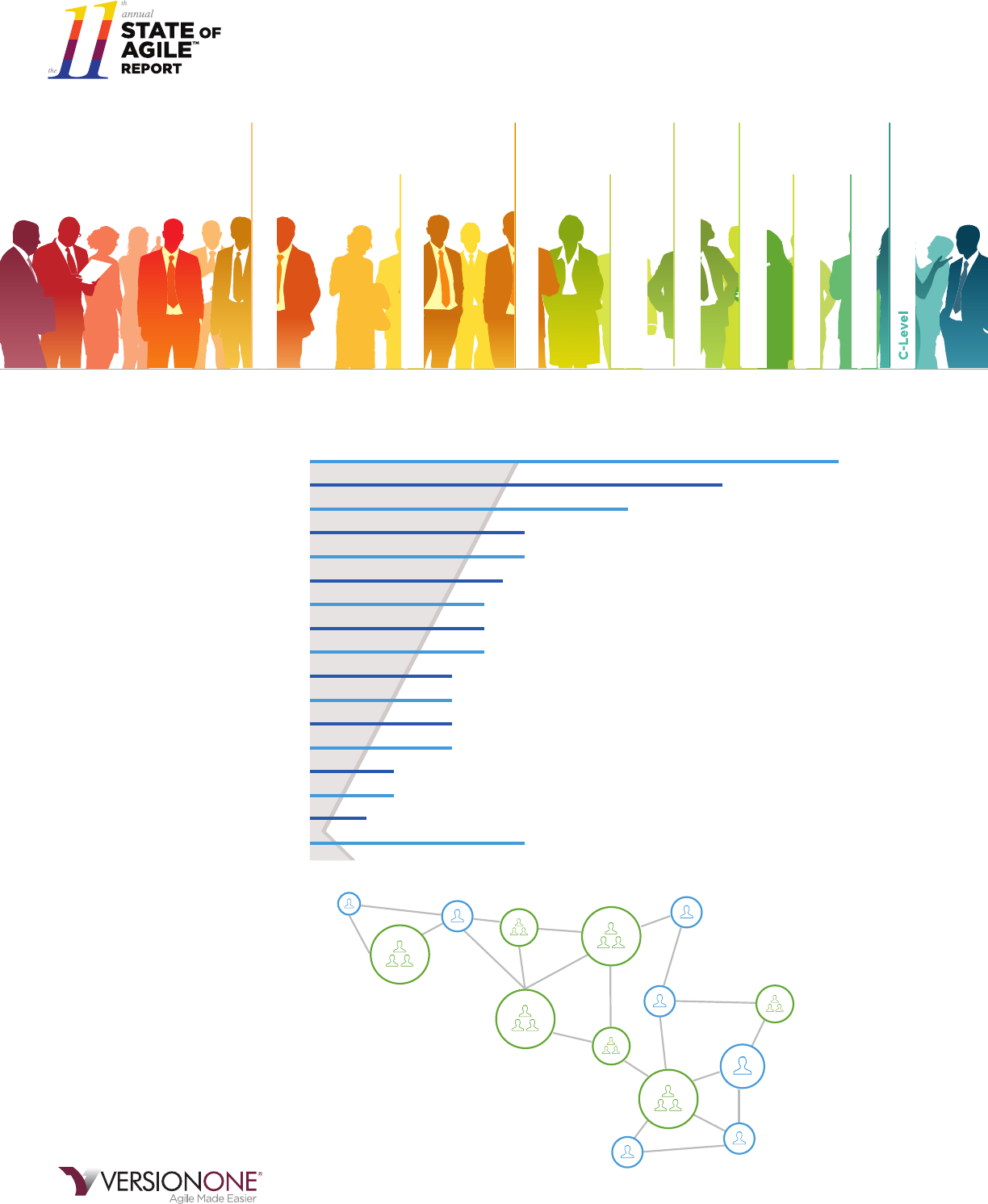
VERSIONONE.COM
6
#StateOfAgile
Role
RESPONDENT DEMOGRAPHICS
23%
Industries
Industries respondents worked in:
15%
13%
19%
6%
5%
14%
2%
3%
Software (ISV)
23%
14%
12%
6%
6%
5%
4%
4%
4%
3%
3%
3%
3%
2%
2%
8%
Financial Services
Professional Services
Insurance
Healthcare
Government
Telecom
Transportation
Manufacturing
Education
Internet Services
Retail
Media & Entertainment
Utilities
Consumer Products
Public Services
• Write-in responses were commonly
Education, Consulting, Aerospace,
Automotive, Hospitality, and Non-Profit.
Project/Program Manager
Development Sta
Development Leadership
Other (ScrumMaster
or Internal Coach)
Product Owner
Business Analyst
Consultant/Trainer
IT Sta
C-Level
Other*
1%
Distributed Agile Teams
86% of respondents had at least some
distributed teams practicing agile.
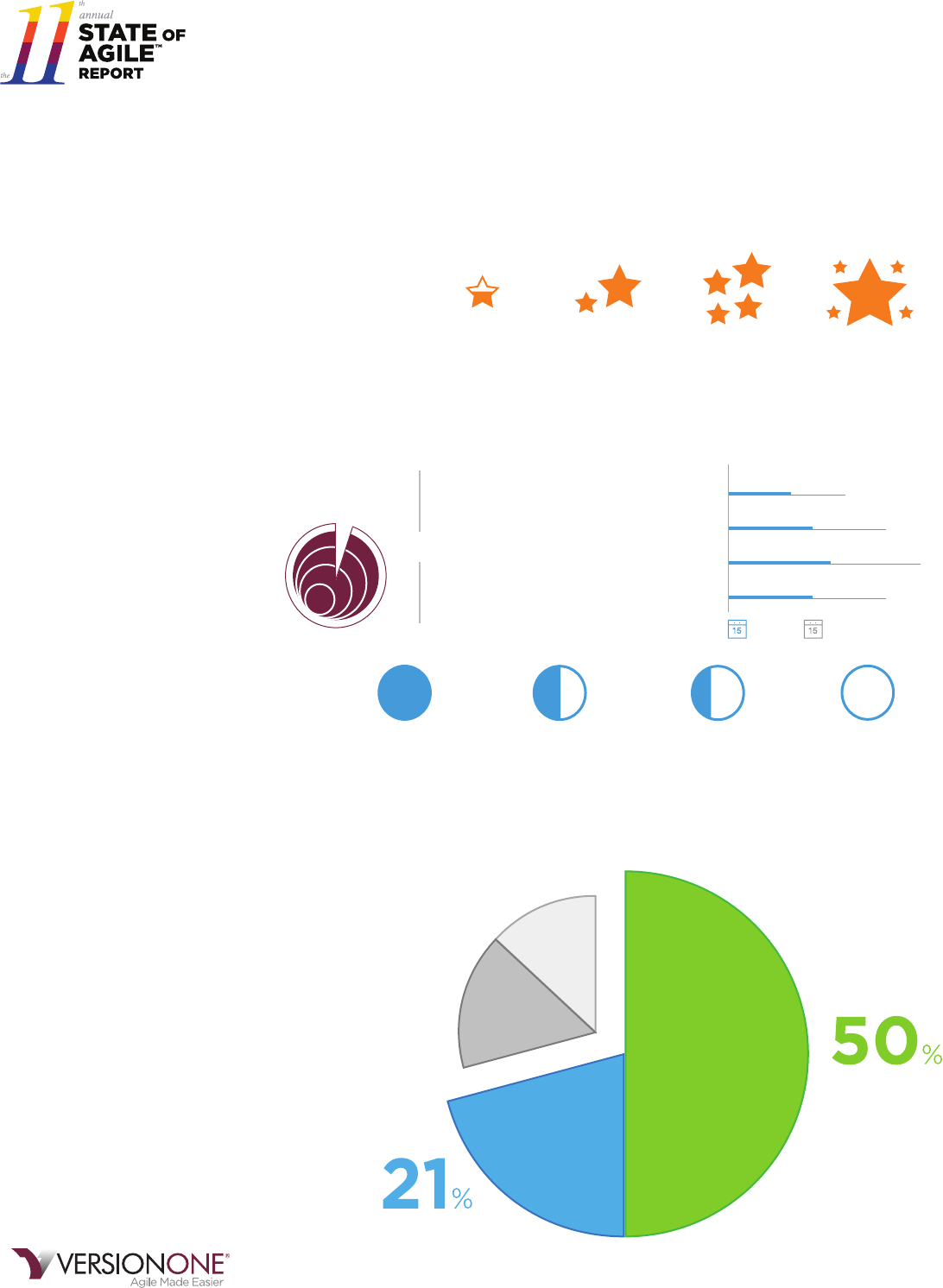
VERSIONONE.COM
7
#StateOfAgile
COMPANY EXPERIENCE
AND ADOPTION
Company Experience
2016
The percentage of respondents’
organizations that practice agile
94%
HOW MANY?
&
HOW LONG?
The length of
time respondents’
organizations have
been practicing agile:
< 1 year
15%
1-2 years
25%
3-5 years
32%
5+ years
28%
19%
24%
32%
25%
2016 2015
Percentage of
Teams Using Agile
60% of respondents stated less than half of
teams in their organizations are using agile
practices.
DevOps Initiatives
71% of respondents stated that they
currently have a DevOps initiative
in their organization or are planning
one in the next 12 months.
8%
All of our teams
are agile
Current DevOps
Initiatives
32%
More than ½ of
our teams are
agile
Planning DevOps
Initiatives
58%
Less than ½ of
our teams are
agile
16%
No DevOps
Initiatives
2%
None of our
teams are agile
13%
I don’t know
Personal Experience with
Agile Development Practices
44%
5+ years
28%
3-4 years
7%
1-2 years
11%
< 1 year
Extremely
knowledgeable
Very
knowledgeable
Moderately
knowledgeable
Very little/no
knowledge
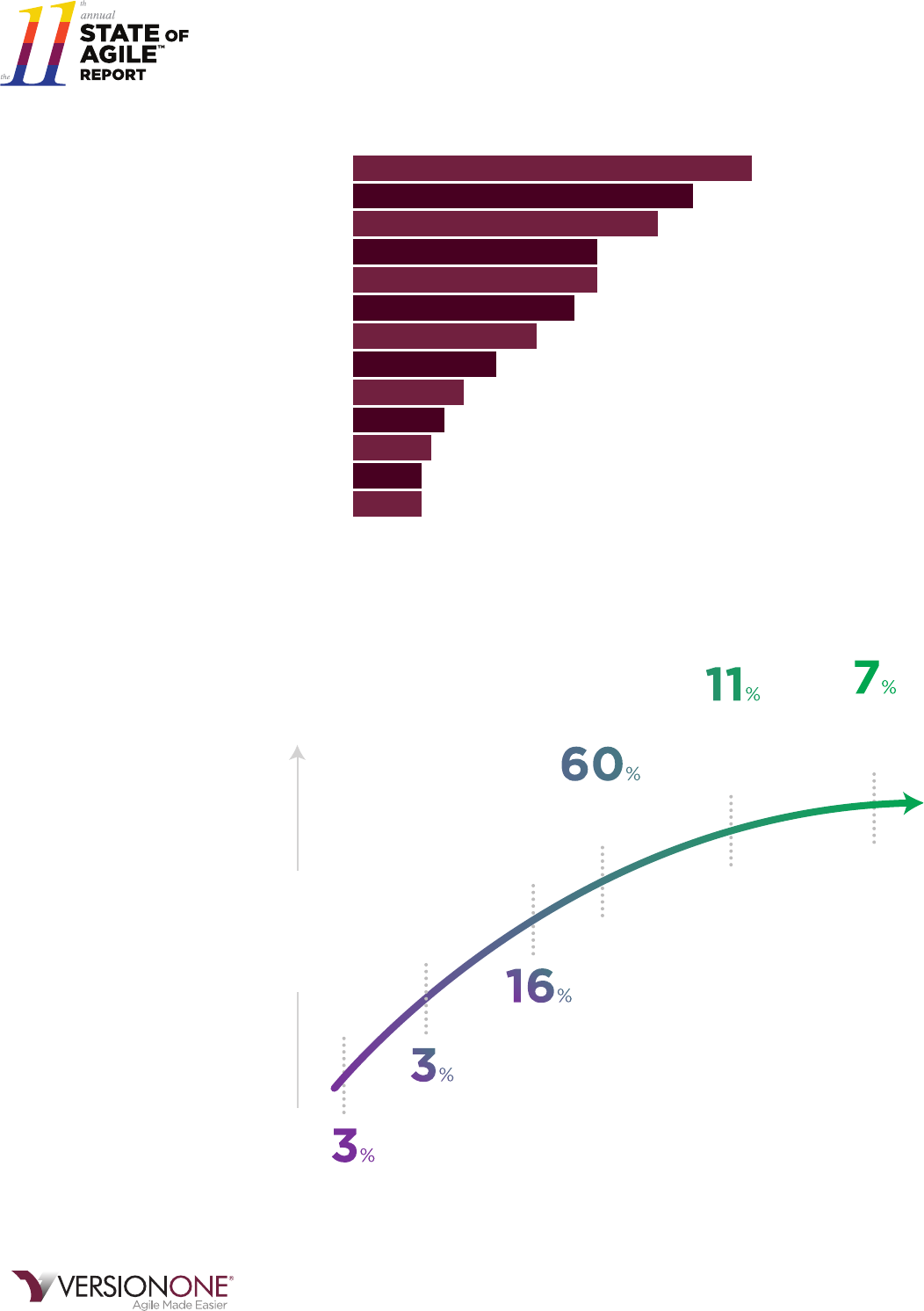
VERSIONONE.COM
8
#StateOfAgile
COMPANY EXPERIENCE AND ADOPTION
Agile Maturity
The vast majority of respondents
(80%) said their organization was
at or below a “still maturing” level.
MATURITY
3%
No initiative
to achieve
enterprise agility
16%
Experimenting
with agile in
pockets
60%
Use agile practices
and techniques but
still maturing
11%
High level of
competency with
agile practices
across the
organization
7%
Enable greater
adaptability to
market with agile
practices
3%
Considering an
agile initiative
Reasons for
Adopting Agile
Improving project visibility (43%) moved
up three places to become the fourth most
popular reason stated for adopting agile
this year and accelerating product delivery
increased from 62% last year to 69% this
year.
*Respondents were able to make multiple
selections.
69%
61%
53%
43%
43%
37%
30%
21%
20%
18%
18%
Accelerate product delivery
Enhance ability to manage changing priorities
Increase productivity
Improve project visibility
Enhance software quality
Improve business/IT alignment
Reduce project risk
Improve team morale
Enhance delivery predictability
Improve engineering discipline
Better manage distributed teams
Reduce project cost
Increase software maintainability
42%
31%
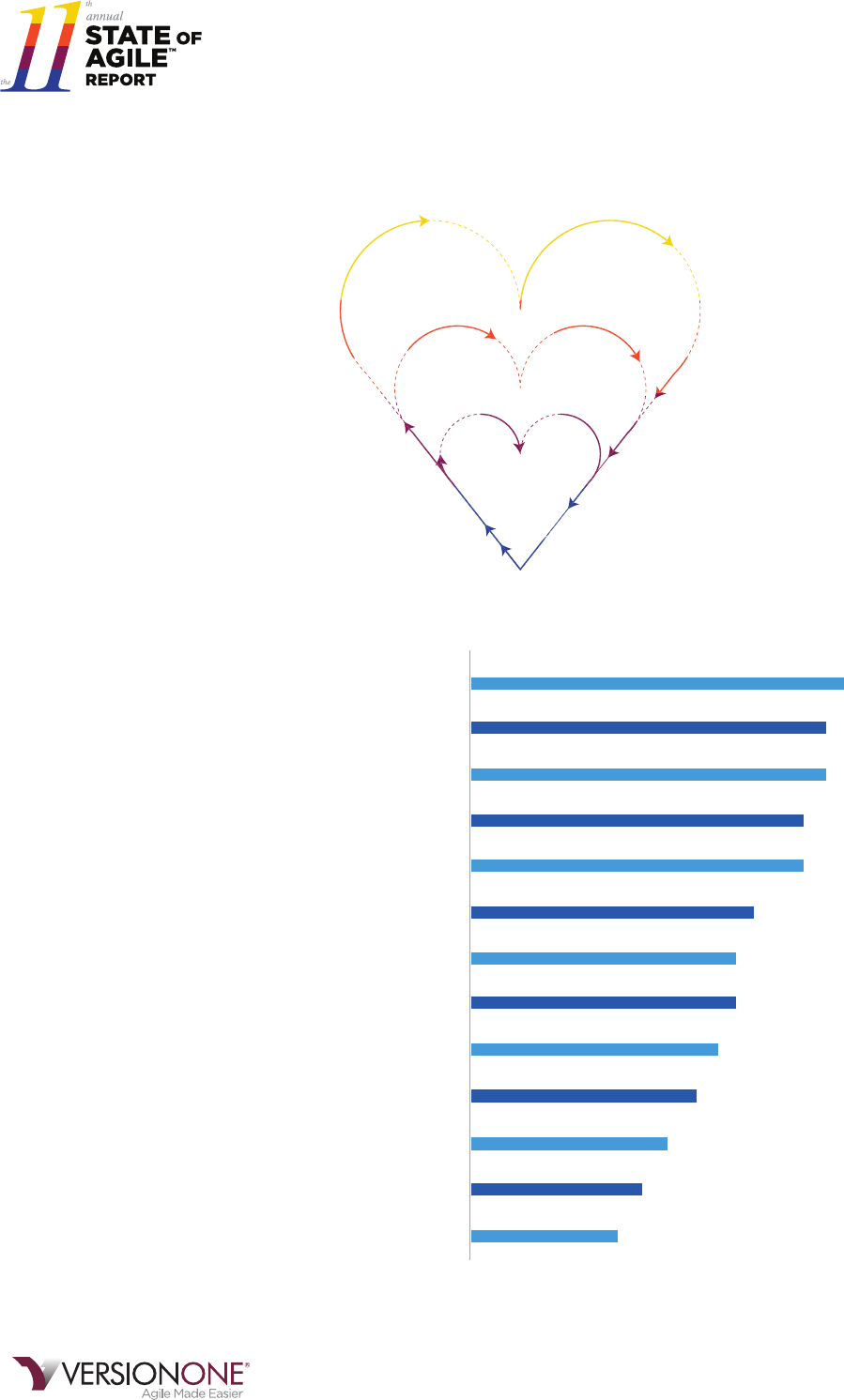
VERSIONONE.COM
9
#StateOfAgile
BENEFITS OF AGILE
Benets of Adopting Agile
Ability to manage changing priorities
Project visibility
Increased team productivity
Delivery speed/time to market
Team morale
Business/IT alignment
Software quality
Project predictability
Project risk reduction
Engineering discipline
Software maintainability
Managing distributed teams
Project cost reduction
88%
83%
83%
81%
81%
76%
75%
75%
74%
68%
64%
61%
56%
*Respondents were able to make multiple selections.
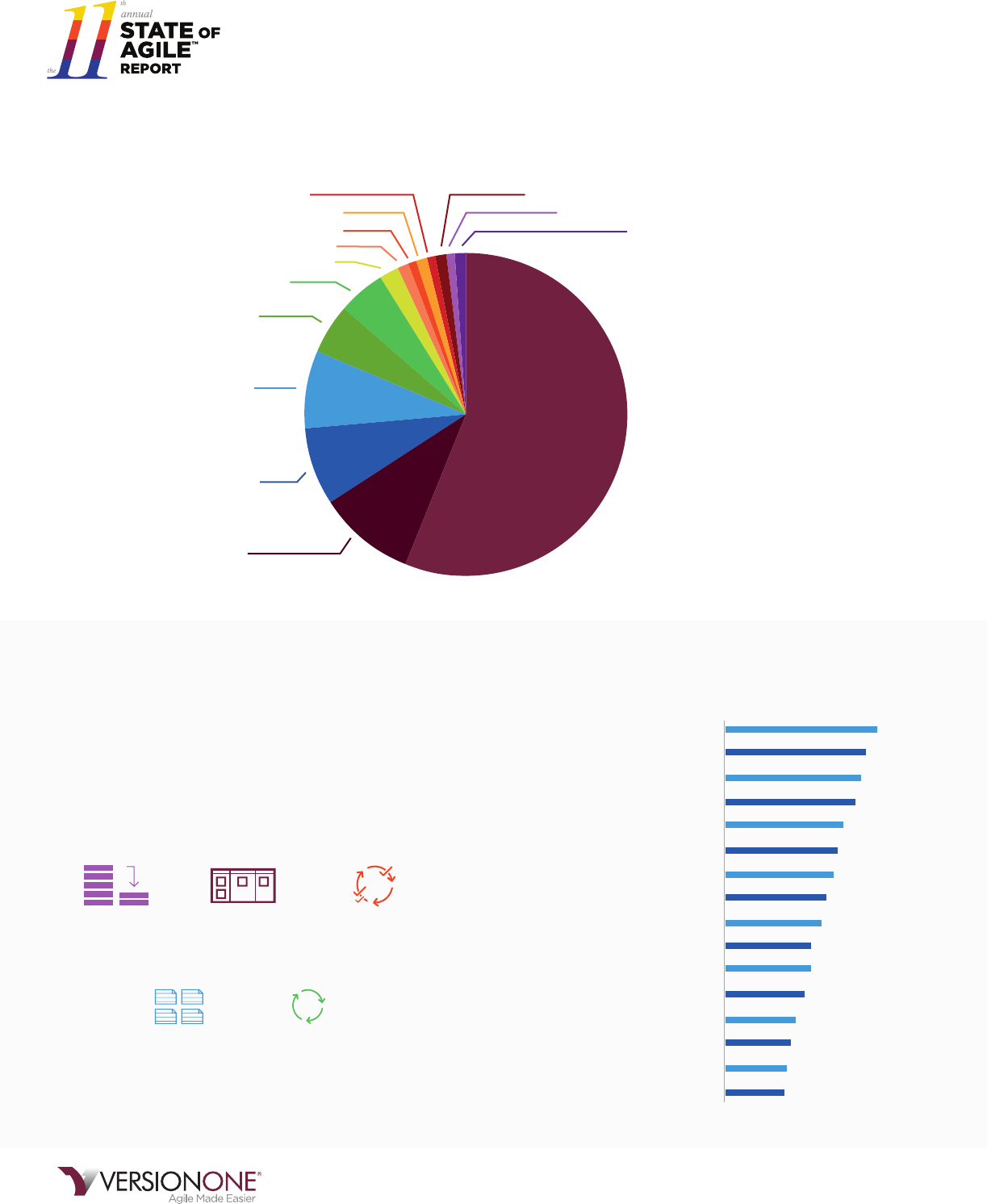
VERSIONONE.COM
10
#StateOfAgile
AGILE METHODS AND
PRACTICES
Agile
Methodologies Used
Scrum and Scrum/XP Hybrid (68%)
continue to be the most common agile
methodologies used by respondents’
organizations.
58%
Scrum
10%
Scrum/XP
Hybrid
8%
Custom Hybrid
(multiple
methodologies)
8%
Scrumban
5%
Kanban
2% I Don’t Know
<1% Agile Unified Process (AgileUP)
<1% XP<1% DSDM/Atern
<1% Feature-Driven Development (FDD)
<1% Lean Startup
1% Lean Development
2% Iterative Development
5% Other
Agile Techniques Employed
From 2015 to 2016, the use of Kanban grew from 39% to 50%; iteration reviews
increased from 54% to 81% and iteration planning went from 69% to 90%.
TOP 5 AGILE
TECHNIQUES
88%
81% 71%
83%
DAILY
STANDUP
ITERATION
REVIEWS
SHORT
ITERATIONS
RETROSPECTIVES
}
Iteration planning
Daily standup
Retrospectives
Iteration reviews
Short iterations
Release planning
Team-based estimation
Dedicated product owner
Single team (integrated dev & testing)
Frequent releases
Kanban
Open work area
Product roadmapping
Story mapping
Agile portfolio planning
Agile/lean UX
90%
88%
83%
81%
71%
66%
62%
55%
54%
50%
50%
45%
38%
35%
25%
22%
*Respondents were able to make multiple selections.
90%
ITERATION
PLANNING
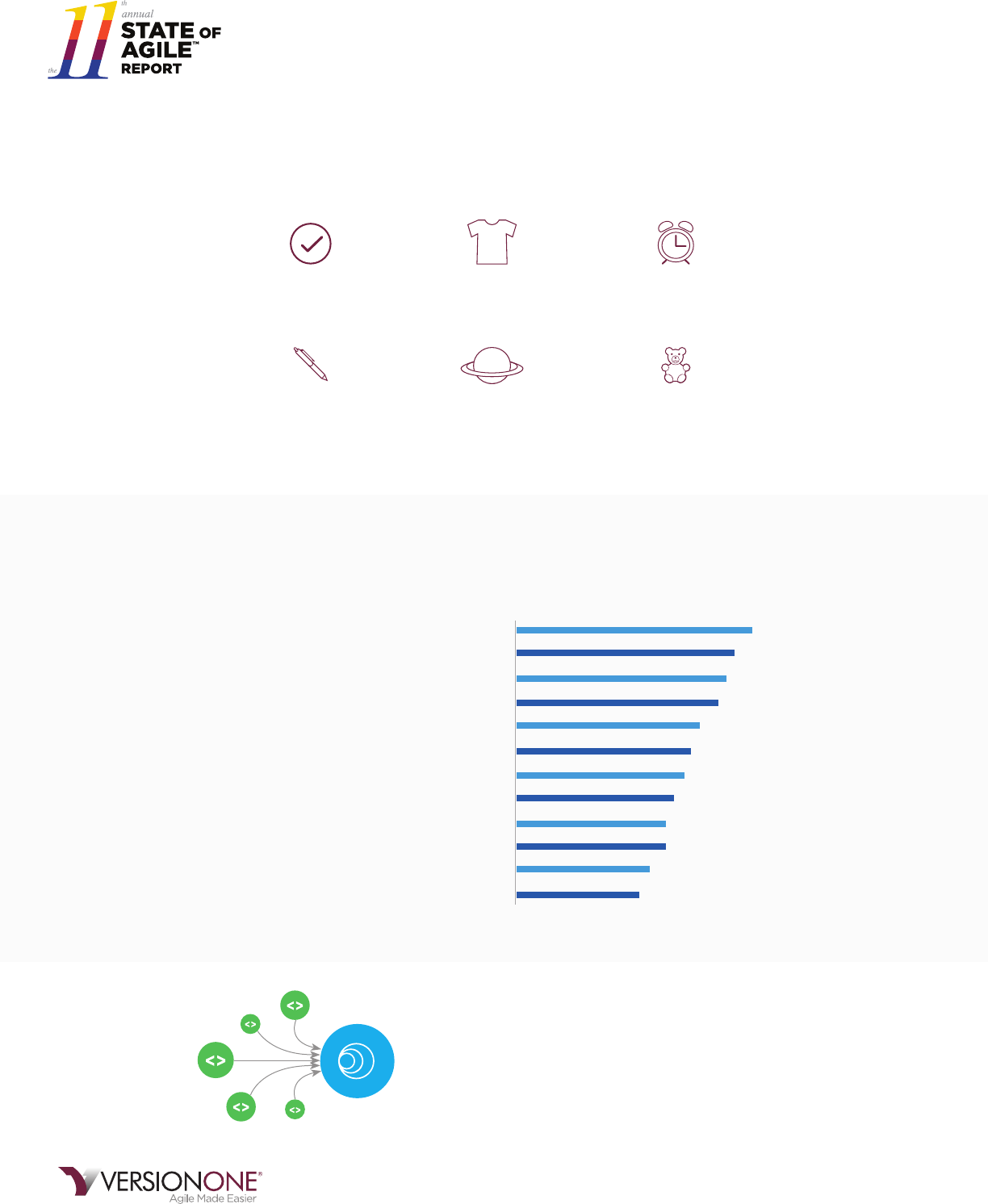
VERSIONONE.COM
11
#StateOfAgile
AGILE METHODS AND PRACTICES
Agile in Outsourced Dev Projects
51% of respondents are using agile practices to manage
outsourced development projects. Respondents were twice
as likely to say that the use of agile within their outsourced
projects was going to increase in the future.
Unit testing
Continuous integration
Coding standards
Refactoring
Test-driven deployment
Automated acceptance testing
Continuous deployment
Pair programming
Sustainable pace
Collective code ownership
Behavior-driven development
Emergent design
74%
61%
56%
52%
40%
36%
35%
32%
31%
31%
16%
15%
*Respondents were able to make multiple selections.
Engineering Practices Employed
While the usage of XP as an independent methodology continues to
decrease (<1%), the practices associated with XP are still prevalent.
Epic Estimation Unit of Measure
When conducting epic estimation, more than half of
respondents said they used a point system.
51%
POINTS
23%
T-SHIRT SIZES
13%
HOURS
6%
SWAG
6%
OTHER
1%
GUMMY BEARS
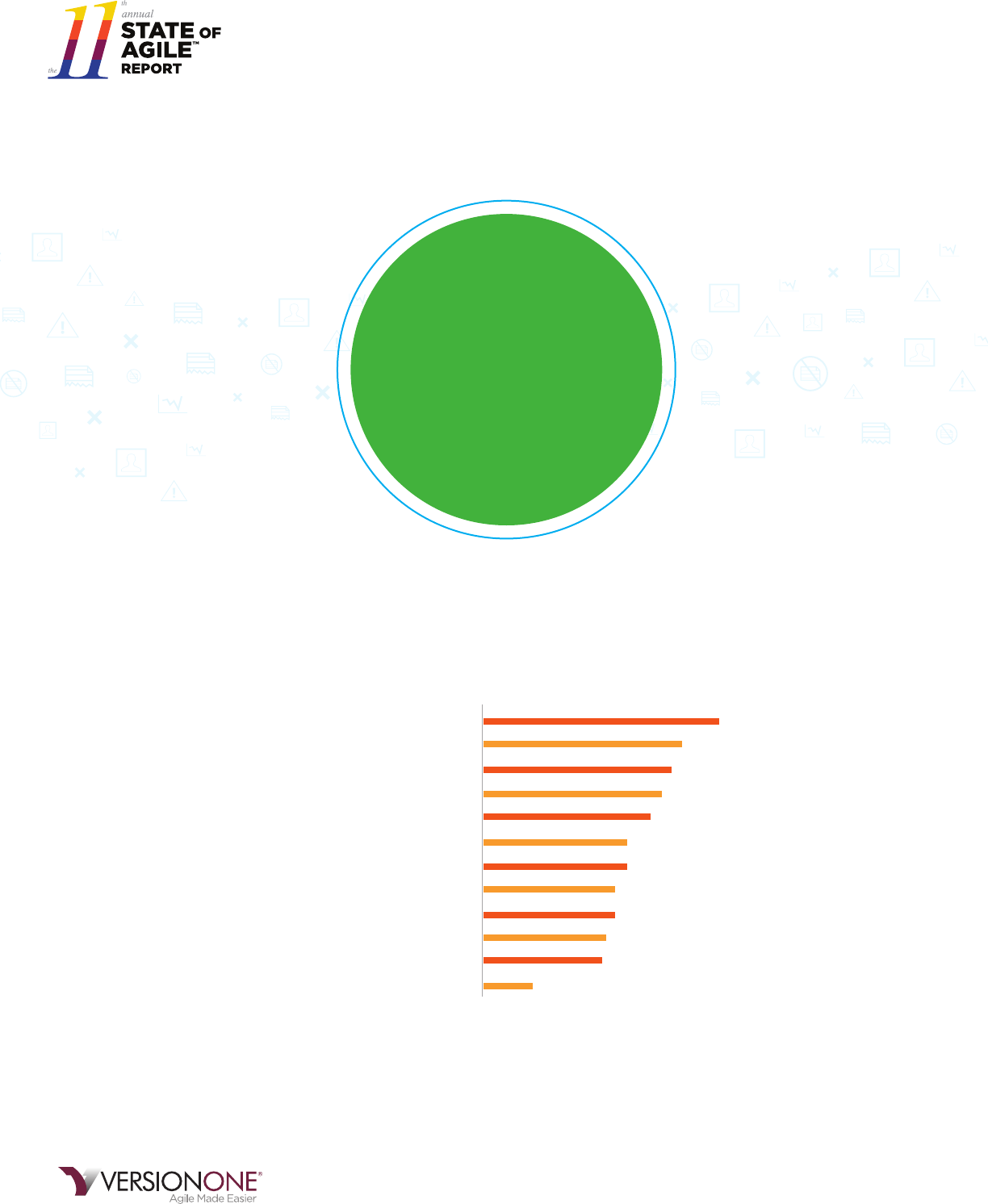
VERSIONONE.COM
12
#StateOfAgile
AGILE SUCCESS
AND METRICS
Challenges Experienced Adopting & Scaling Agile
While the vast majority of respondents and their organizations have realized success from
adopting agile practices, they recognize that there are challenges to scaling agile. The top
two challenges cited were organizational culture at odds with agile values (63%), and lack of
skills or experience with agile methods (47%).
Company philosophy or culture at odds with core agile values
Lack of experience with agile methods
Lack of management support
General organization resistance to change
Lack of business/customer/product owner
Insucient training
Pervasiveness of traditional development
Inconsistent agile practices and process
Fragmented tooling, data, and measurements
Ineective collaboration
Regulatory compliance and governance
Don’t know
63%
47%
45%
43%
41%
34%
34%
31%
20%
19%
15%
2%
*Respondents were able to make multiple selections.
98%
of respondents said that their
organization has realized
success from agile projects.
Success of
Agile Projects
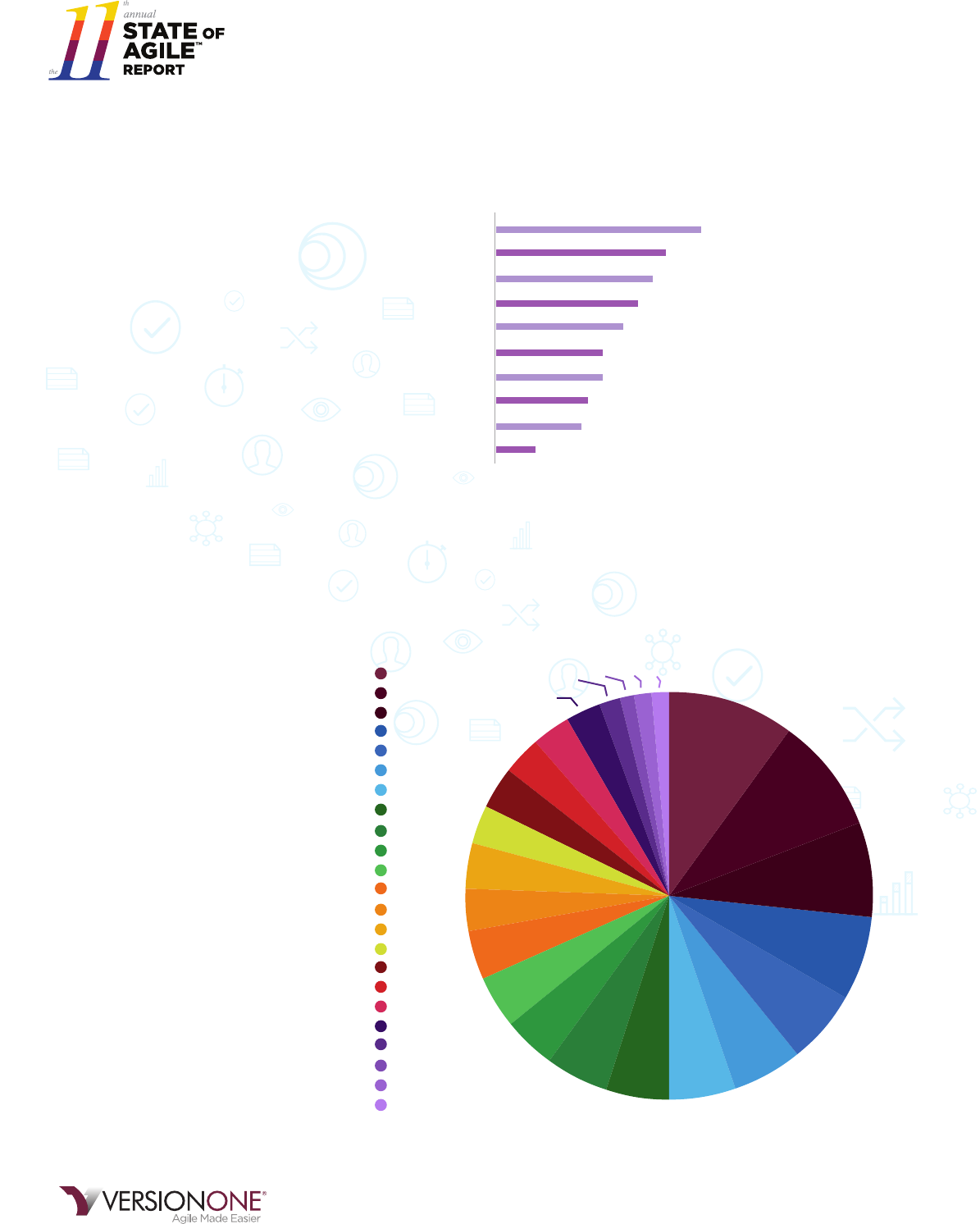
VERSIONONE.COM
13
#StateOfAgile
How Success Is Measured...
with Agile Initiatives?
Business value as a measure of an agile initiative’s success went from fourth in 2015 to
second in 2016. On-time delivery of projects and customer/user satisfaction remained in the
top three measures of agile initiative’s success as they have in the past few years.
On-time delivery
Business value
Customer/user satisfaction
Product quality
Product scope
Productivity
Project visibility
Predictability
Process improvement
Don’t know
53%
46%
44%
42%
40%
25%
25%
23%
21%
11%
*Respondents were able to make multiple selections.
How Success Is Measured...
with Agile Projects
While business value was cited as the second most popular measure (46%) of an agile initiative’s success, it ranked as the
eleventh most popular measure (23%) of an agile project’s success. Velocity (67%) continues to be the number one measure of
an agile project’s success.
Velocity
Iteration burndown
Release burndown
Planned vs. actual stories per iteration
Burn-up chart
Work-in-Process (WIP)
Defects into production
Customer/user satisfaction
Planned vs. actual release dates
Cycle time
Defects over time
Business value delivered
Budget vs. actual cost
Defect resolution
Cumulative flow chart
Test pass/fail over time
Scope change in a release
Estimation accuracy
Individual hours per iteration/week
Earned value
Product utilization
Revenue/sales impact
Customer retention
*Respondents were able to make multiple selections.
AGILE SUCCESS AND METRICS
67%
51%
38%
37%
34%
32%
30%
28%
26%
23%
23%
23%
22%
20%
19%
16%
15%
8%
7%
7%7%
16%
15%
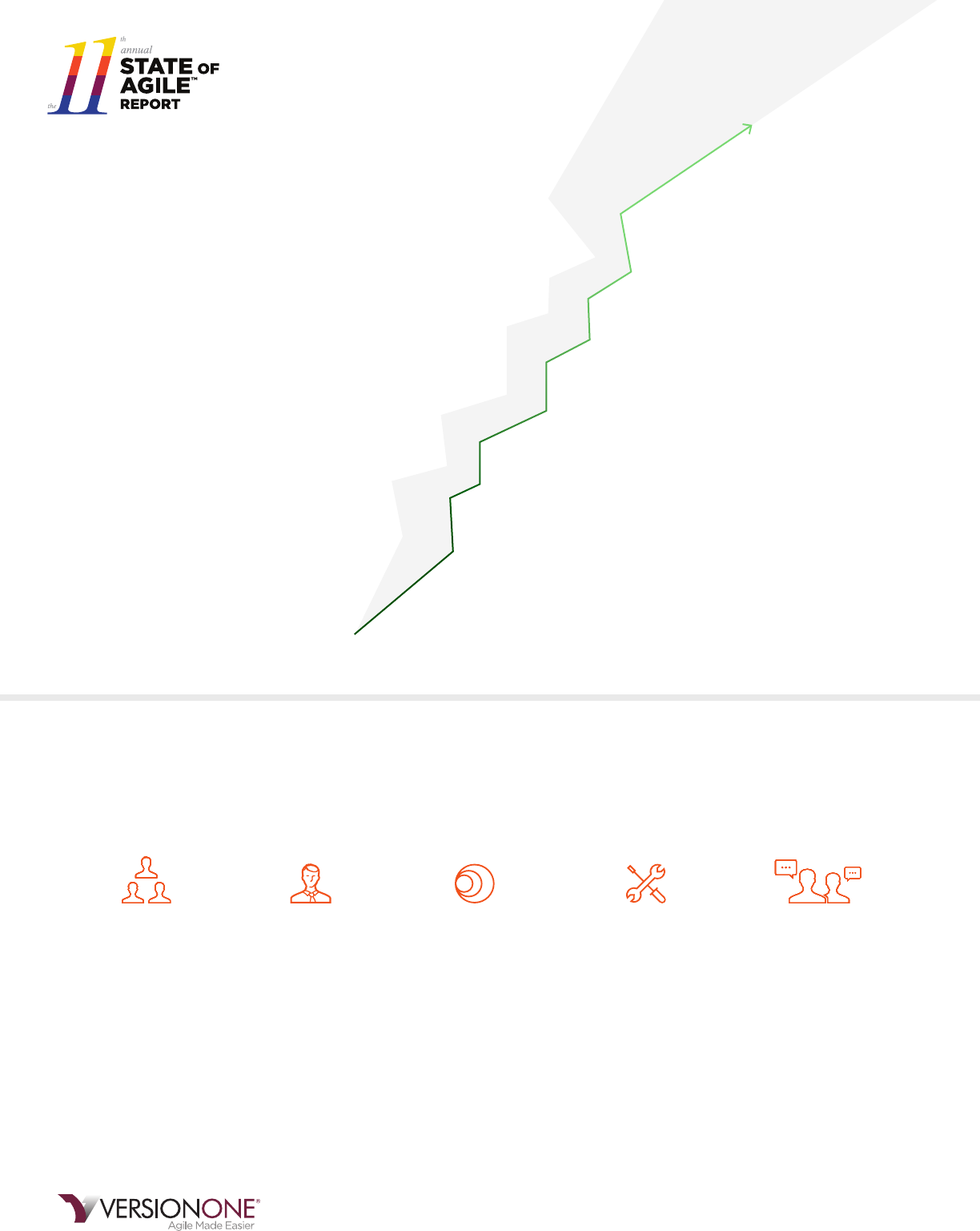
VERSIONONE.COM
14
#StateOfAgile
SCALING AGILE
Scaling Methods
and Approaches
SAFe (28%) has overtaken SCRUM/SCRUM of
SCRUMS (27%) to be the most popular scaling
method cited by respondents.
Top 5 Tips for Success with Scaling Agile
Executive sponsorship (48%), consistent process and practices (41%), implementation of a common tool across
teams (36%), and agile consultants or trainers (36%) continue to be cited in the top five tips for successfully scaling
agile for the past few years and likely points to the long-term importance of self-suciency when scaling agility. The
top cited tip this year, internal agile coaches (52%), was a new entry into the top five.
Other important factors included: externally attended classes or workshops,
company-provided training program, online training, and webinars.
*Respondents were able to make multiple selections.
NEXUS
RECIPES FOR AGILE GOVERNANCE IN THE ENTERPRISE (RAGE)
DISCIPLINED AGILE DELIVERY (DAD)
LARGE-SCALE SCRUM (LESS)
AGILE PORTFOLIO MANAGEMENT (APM)
LEAN MANAGEMENT
INTERNALLY CREATED METHODS
SCRUM / SCRUM OF SCRUMS
SCALED AGILE FRAMEWORK
®
(SAFE
®
)
28%
27%
13%
4%
1%
1%
1%
4%
3%
41%
CONSISTENT
PROCESS AND
PRACTICES
36%
IMPLEMENTATION
OF A COMMON TOOL
ACROSS TEAMS
36%
AGILE CONSULTANTS
OR TRAINERS
48%
EXECUTIVE
SPONSORSHIP
52%
INTERNAL AGILE
COACHES
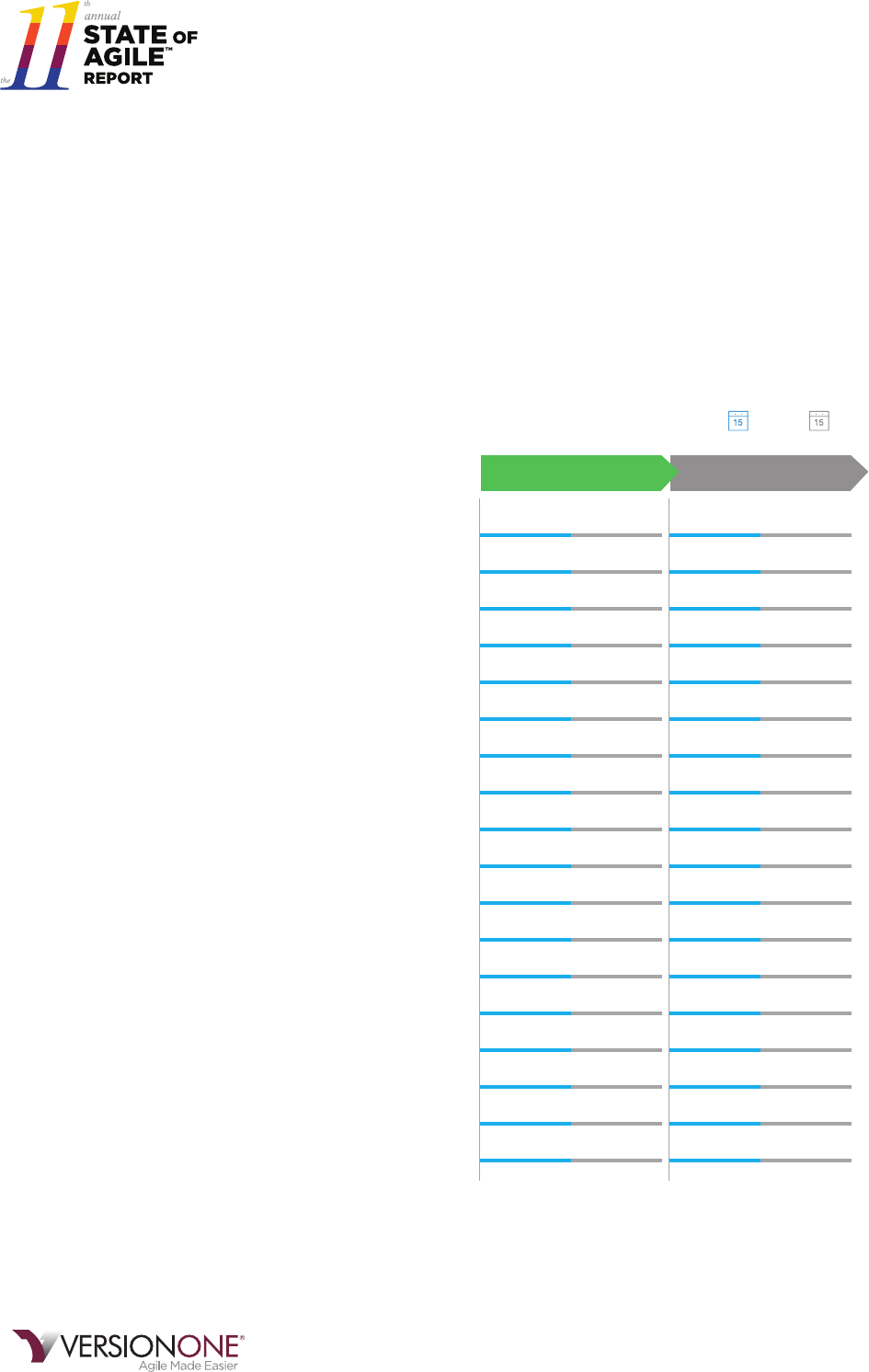
VERSIONONE.COM
15
#StateOfAgile
8%
FUTURE PLANS TO USE
10%
10% 10%
11% 13%
5% 5%
17% 17%
13% 12%
19% 23%
22% 22%
27% 28%
31% 34%
19% 22%
5% 7%
25% 27%
36% 41%
10% 11%
30% 32%
25% 30%
26% 30%
AGILE PROJECT
MANAGEMENT TOOLS
General Tool Uses and Preferences
More than three-quarters of respondents are currently using a taskboard. Notable
changes in tool use from 2015 to 2016 were Kanban boards (+6% YOY) and
spreadsheets (-7% YOY).
Taskboard
75%
2016 2015
CURRENT TOOL USAGE
82%
71% 80%
69% 63%
67% 74%
63% 71%
62% 68%
61% 66%
59% 66%
52% 57%
44% 50%
43% 51%
43% 51%
35% 42%
35% 38%
34% 43%
25% 33%
Bug tracker
Kanban board
Spreadsheet
Agile project management tool
Wiki
Unit test tool
Automated build tool
Continuous integration tool
Release/deployment automation tool
Requirements management tool
Traditional project management tool
Project & portfolio management (PPM) tool
Automated acceptance tool
Index cards
Story mapping tool
Refactoring tool
Customer idea management tool
25% 30%
16% 21%
*Respondents were able to make multiple selections.
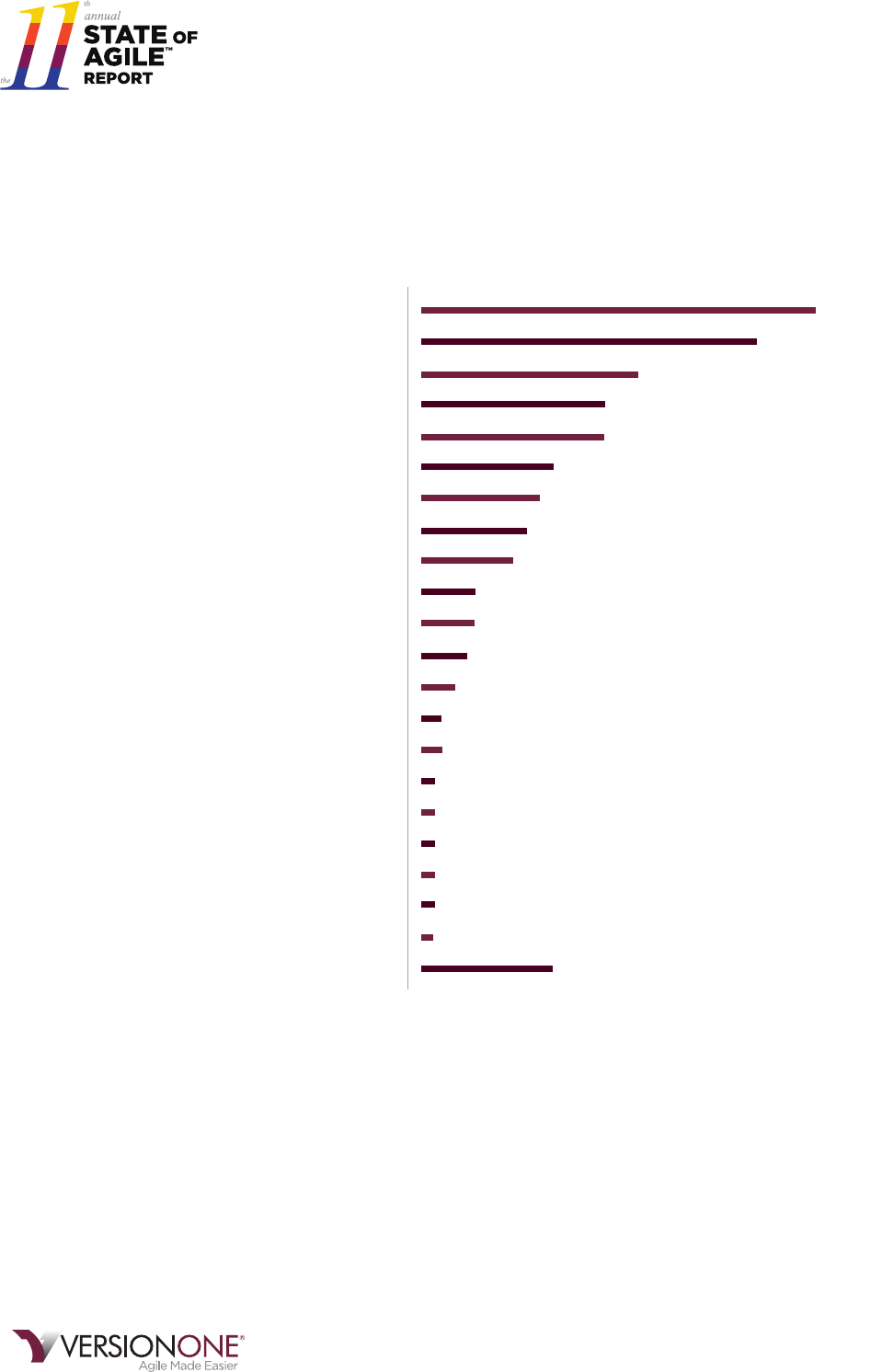
VERSIONONE.COM
16
#StateOfAgile
Use of Agile Management Tools
Fewer respondents cited using Microsoft® Excel this year (46%) then last year (60%)
and Google Docs dropped from (18%) last year to (14%) this year.
Atlassian/JIRA
Microsoft Excel
Microsoft TFS
Microsoft Project
VersionOne
Google Docs
CA Agile Central
HP Quality Center/ALM
In-house/home-grown
Bugzilla
LeanKit
IBM Rational Team Concert
HP Agile Manager
Pivotal Tracker
No tools at all
Axosoft
CollabNet ScrumWorks Pro
CollabNet TeamForge
Hansoft
Target Process
ThoughtWorks Mingle
Other
AGILE PROJECT MANAGEMENT TOOLS
Respondents were able to make multiple selections.
53%
46%
22%
20%
13%
10%
5%
3%
2%
1%
1%
20%
14%
12%
5%
4%
2%
1%
1%
1%
14%
1%

VERSIONONE.COM
17
#StateOfAgile
Recommended Agile Project Management Tools
Respondents were asked whether they would recommend the tool(s) they are using
based on their past or present use. For the fifth year in a row, VersionOne had the highest
recommendation rate of any other tool evaluated in the survey (87%).
VersionOne
Atlassian/JIRA
CA Agile Central
LeanKit
Microsoft TFS
Target Process
Axosoft
Collabnet ScrumWorks Pro
Pivotal Tracker
Google Docs
HP Agile Manager
ThoughtWorks Mingle
IBM Rational
Microsoft Excel
Microsoft Project
HP Quality Center/ALM
Bugzilla
Collabnet TeamForge
In-house/home-grown
Hansoft
AGILE PROJECT MANAGEMENT TOOLS
Respondents were able to make multiple selections.
87%
81%
76%
63%
60%
57%
52%
39%
31%
25%
25%
75%
62%
60%
56%
46%
37%
30%
25%
20%
VERSIONONE.COM
© 2017 VersionOne Inc. All rights reserved.
VersionOne is a registered trademark and State of Agile is a trademark of VersionOne Inc.
Scaled Agile Framework and SAFe are trademarks of Scaled Agile, Inc.
